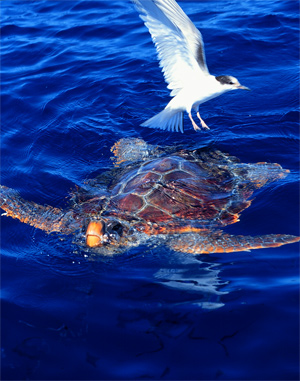
Photo: Sonia Mendes
CTURTLE
To improve communication among individuals around the world who are interested in sea turtle biology and conservation, the ACCSTR established and manages CTURTLE — a Listserv discussion network with over 1600 subscribers from more than 50 countries. Messages to CTURTLE are archived in the CTURTLE Archives.
Sea Turtle Online Bibliography
The ACCSTR developed and manages the Sea Turtle Online Bibliography which includes over 21,000 references on all aspects of sea turtle biology, conservation and management. The bibliography is available over the Internet and is continually updated.
Report a Tag
Tags are affixed to sea turtles by programs around the world to learn more about many aspects of their biology including migratory patterns, growth rates, survival, and reproductive output. Information on sightings of tagged turtles is critical information for these studies.
Cooperative Marine Turtle Tagging Program (CMTTP)
The ACCSTR, in cooperation with the National Marine Fisheries Service Southeast Fisheries ScienceCenter, has developed a centralized program to distribute sea turtle tags, manage tagging data, and facilitate exchange of tag information.
Sea Turtle Tag Inventory
The ACCSTR is maintaining the Sea Turtle Tag Inventory to avoid further duplication of tag numbers when tags are purchased by different research programs and to assist in reporting recapture data for turtles when only the tag number has been recorded. We invite our colleagues to send us their lists of tag series that have not come from either the ACCSTR or CMTTP so that we can add those tag series to the inventory. The greater the participation, the greater the potential to meet the objectives of the inventory.
Marine Turtle DNA Sequence Patterns
The ACCSTR has developed a website to facilitate marine turtle population genetic studies. As the number of laboratories conducting marine turtle genetics research increases and the chances for duplicating sequence designations increases, the coordination for identifying, naming, and cataloging sequence patterns becomes more critical. In an effort to facilitate this coordination and to avoid the confusion of duplication of sequence designations in publications, we have established this website for listing DNA sequence patterns.

Legacy Database Initiative
The ACCSTR has developed the Legacy Database Initiative (Preserving the Past to Save the Future) to: (1) preserve, archive, and computerize the unique and valuable data that have been collected on sea turtle populations from Florida and around the world over the past decades; (2) organize the necessary metadata associated with these data; and (3) ensure that these data are available to future generations of sea turtle biologists and conservationists to promote sea turtle conservation. We envision that some databases will allow for complete access while others may have restricted access depending on the wishes of the data collectors.
Hematocrit and Plasma Biochemical Data
To monitor the physiological status of wild populations of sea turtles to ensure recovery of these threatened and endangered species, baseline hematocrit and blood biochemical reference intervals need to be established. To accomplish this recovery goal, a multidisciplinary collaboration has been developed that includes the College of Veterinary Medicine (UniversityofFlorida), the ACCSTR, the St. Lucie Power Plant (Florida Power and Light Corporation), the Marinelife Center of Juno Beach, and the Clearwater Marine Aquarium.
Satellite Telemetry Tracking Projects
The ACCSTR has developed a number of satellite telemetry projects to determine the migratory and distribution patterns of sea turtles. The ACCSTR is using state-of-the-art satellite remote sensing technologies to evaluate sea turtle movement patterns and to identify environmental cues for these patterns.